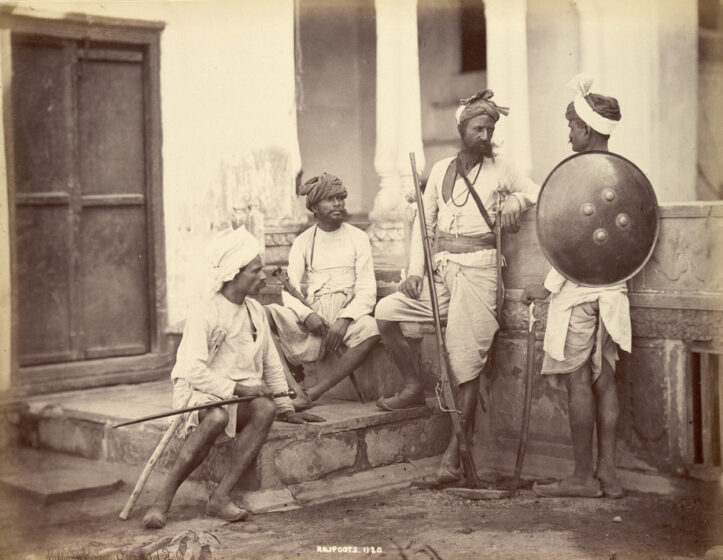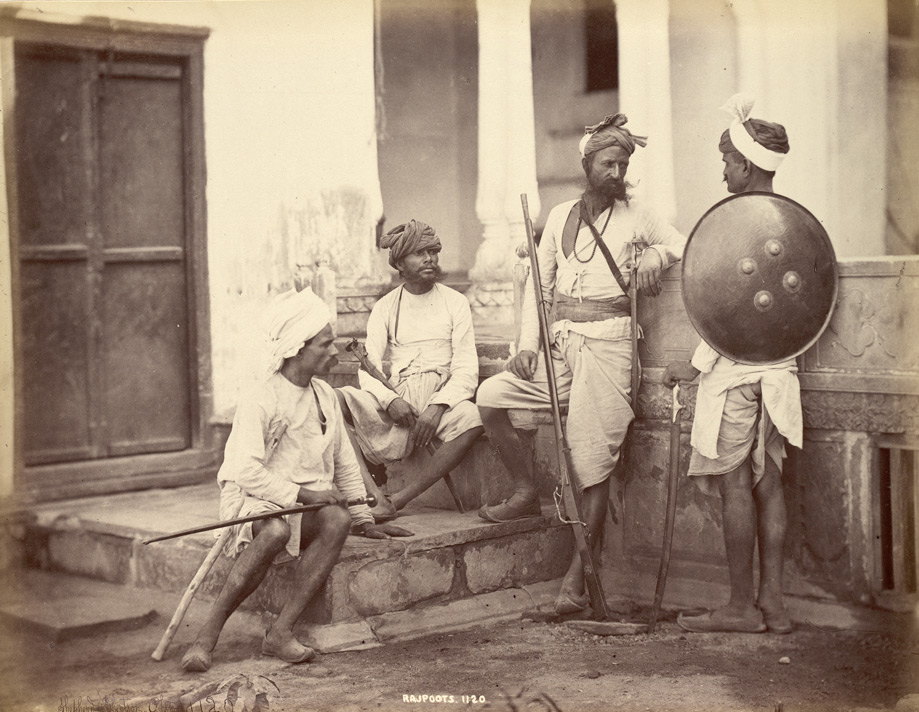
September 13, 2023

Chohan Rajpoots, Delhi. Circa 1868
Source: Public Domain
India is in the spotlight as it throws the G20 economic conference. Its host, Hindu nationalist prime minister Narendra Modi, is fooling around, Elon Musk-style, with the idea of changing the name of his country to “Bharat” as an anti-colonial gesture. And the California legislature has, after much acrimony among Hindus, sent a bill to governor Gavin Newsom’s desk outlawing the ancient Hindu tradition of caste discrimination.
Americans never had to think about caste before, but it’s not too unlikely that both vice presidential candidates in 2024 will be Tamil Brahmins: Kamala Harris and Vivek Ramaswamy.
Indian prime minister Modi, an energetic right-winger, is the man who gets the toilets installed on time. Modi strenuously attacked India’s worst problem—lack of sanitation—by having 110 million toilets hooked up in his first half decade in office.
“Modi supporters in America tend to fear that recognizing caste discrimination in American law will cause anti-high-caste affirmative action to pursue them here.”
More generally, he’s trying to build national unity and effectiveness by promoting old-fashioned nationalism. For a couple of years, for instance, movie audiences were ordered to stand for the playing of the national anthem before the feature, rather like how American baseball fans began standing for “The Star-Spangled Banner” during WWII.
But what do India’s 1.4 billion people have in common? Traditionally, Indians saw themselves, not unreasonably, less as a nation than as a world. Gandhi never even pondered the concept of Indian nationalism until he moved to South Africa and was shocked to find himself viewed not as a member of a particular Gujarat merchant subcaste, but as just another Indian.
But Indian nationalism of the Congress Party ilk tended to be a bloodless mix of secularism, Fabian socialism, and elite Anglophilia. (In 1992, on the pre-WWW internet, I was involved in starting a discussion group devoted to P.G. Wodehouse, author of comic stories about Bertie Wooster and Jeeves, the perfect valet. About half the other founding members, all internet pioneers, were Indians.) This rather postmodern (or premodern) ethos worked fairly well for reconciling India’s minorities, such as Muslims, Christians, and Dalits, the despised untouchables who lack a caste under Hinduism.
But it was less than galvanizing for the Hindu majority. Modi is attempting to build national purpose and energy around Hinduism, the way Americans traditionally found unity in the ideals of the founding fathers.
But Hinduism is rather different from Enlightenment American thinking.
For example, Modi’s rule has energized rural vegetarian vigilantes who attack Christians and Muslims accused of butchering sacred cows.
And of course there’s the despicable caste system, which has been central to Hinduism for thousands of years. Economic historian Gregory Clark’s study of surnames found relatively little social mobility over the generations anywhere in the world, but, by far, the least of all in India.
Indians abroad, ashamed of caste, have taken to the postmodern fallacy that caste is a modern invention, socially constructed under British rule.
But Harvard’s superstar geneticist David Reich found instead from ancient DNA:
Rather than inventions of colonialism as Dirks suggested, long-term endogamy as embodied in India today in the institution of caste has been overwhelmingly important for millennia.
Basically, the Aryan steppe warriors who invaded India thousands of years ago installed themselves at the top of an elaborate social pyramid in which their descendants are still privileged. (It’s possible that caste had already existed in India, and the Aryans merely culturally appropriated an existing system. After all, their cousins who went west to overwhelm Western Europe tended toward much less convoluted methods of privilege, such as the three estates of ancient régime France.)
Modi tends to make slightly dizzy but, I have to admit, public-spirited Ronald Reagan-style pronouncements redefining caste, such as “Indianness is our only caste” and
Only two castes will remain in this country. And the country is going to be focused on only these two castes…. The first caste in India is the poor. And the second caste is of people who contribute whatever little to free the country from poverty.
Still, it’s hard to promote Hindu identity without giving some bulwarking to its ancient essence of caste.
The caste system has been illegal since Indian independence in the 1940s. And since 1950, India has had a massive “reservation” system of affirmative action for the Scheduled Tribes, Scheduled Castes, and Other Backward Castes.
In practice, the caste system has tended to fade in importance in India’s cities, but it remains entrenched in the countryside.
What about in America? Does the crazy caste system survive the trip around the world?
It’s hard to say.
Various progressive organizations have started a campaign to outlaw caste discrimination in the United States, but it’s difficult to guess how pressing the problem is in this country, where dysfunctional caste prejudices are an obstacle to making money. Bangladeshi-American Razib Khan, who has a long track record of wise judgments, argues that caste in this country is a minor factor compared with regional ethnic origins, e.g., northern Indians vs. southern Indians. The state of California sued Cisco Systems for caste discrimination in 2020 but called off its charges against specific high-caste managers this year.
It’s tough to tell. Only a tiny percentage of Indian-Americans are Dalits, and American authorities don’t collect caste identities, so it’s virtually impossible to assemble data on whether upper-caste FAANG managers in Silicon Valley discriminate against their handful of untouchable employees and job applicants.
In the distant past, a sizable percentage of Indian immigrants were genteel Brahmin elites who knew better than to try to publicly defend caste, India’s most indefensible predilection. But lately, Indian immigrants tend more to be bumptious Hindu nationalists with cultural chips on their shoulders.
Razib says that Brahmins make up 6 percent of the Indian population but 25 percent of Indians in America of Hindu background. The upper 18 percent of the Hindu caste pyramid make up 83 percent of Hindus in America, while the 200 million Dalits and others at the bottom make up only 1 percent in America.
Some Indian-Americans are refugees from India’s own affirmative-action system, who have come to America where nobody will put them down for being high-caste. In fact, America offers a couple of affirmative-action programs catering to fresh-off-the-767 Indian immigrants, such as the Small Business Administration’s low-interest minority business development loan and government contracting set-asides for nonwhites.
South Asians smartly engaged in Flight From White in the 1970s. They had imprudently persuaded the Census Bureau to call them Caucasian on the 1970 Census, only to discover to their horror that the invention of affirmative action in 1969 meant that their East Asian rivals were eligible as “Orientals” for Small Business Administration minority development low-interest loans and government contracting minority set-asides. So on the 1980 Census, South Asians got themselves privileged to be lumped in with East Asians as the new “Asian” minority.
On the other hand, as a few prescient Indian-American seers had anticipated, by the 2020s, the more mentally agile American institutions, such as Harvard, figured out that Indian immigrant applicants tended to be much higher-IQ than blacks, Hispanics, and Native Americans and thus imposed racial quotas upon them, much like they do to whites.
Modi supporters in America tend to fear that recognizing caste discrimination in American law will cause anti-high-caste affirmative action to pursue them here.
The Republican-dominated Supreme Court recently outlawed racial preferences at Harvard, which should benefit South Asians. But will they vote Republican in gratitude?
It could be that future Modi-supporting Indian-Americans will tend to be so Trumpist in personality that they vote Republican.
They fear caste discrimination laws could lead to affirmative action for the lower orders here.
On the other hand, there’s far more evidence that Indian managers discriminate against whites and East Asians in Silicon Valley. I don’t know how to test this, but whenever I bring it up, I get innumerable comments suggesting that Indian managers in the U.S. are just as ethnonationalist in hiring as their support for Modi would suggest. In contrast, I seldom hear complaints about East Asians in Silicon Valley being prejudiced in favor of their fellow co-racials.
If higher-caste Hindus in California are discriminating in hiring against lower-caste Hindus, as the state legislature alleges, what are the chances they are also discriminating against non-Hindus, such as whites, East Asians, blacks, and Latinos?
Pretty high, right? Maybe that deserves some attention?
So far, there’s no indication of Indians moving to the right in response to their economic success or to Republican anti-affirmative-action moves. In 2020, both parties explicitly campaigned for the Indian-American vote. Trump concentrated on his partnership with Modi, while Biden emphasized his support for relatives of Indian voters immigrating. An October 2020 poll found Biden ahead 72–22 among Indian-Americans.
So, at present there’s little suggestion of an Indian-American shift to the right. At the moment, they tend to be aggressively anti-Christian and antiwhite, racistly failing to distinguish between white Brits who humiliated them by offhandedly imperializing them and white Americans who had zero to do with the Raj.
The most likely resolution of white Americans eventually becoming aware of Hindu-on-Hindu caste prejudice is that we’ll come up with some policy that punishes random white people. For example, we’ll probably decide that all 200,000,000 Dalits in India have a presumptive right to be refugees in America and to get affirmative action once they are here.
When we do, don’t expect to be appreciated for it.

